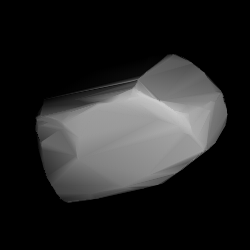astro.wikisort.org - Asteroid
1961 Dufour (prov. designation: 1973 WA) is a large background asteroid, approximately 50 kilometers (31 miles) in diameter, located in the outer region of the asteroid belt. It was discovered on 19 November 1973, by Swiss astronomer Paul Wild at Zimmerwald Observatory near Bern, Switzerland, and later named for 19th-century Swiss General Henri Dufour.[2][8]
 Modelled shape of Dufour from its lightcurve | |
| Discovery[1] | |
|---|---|
| Discovered by | P. Wild |
| Discovery site | Zimmerwald Obs. |
| Discovery date | 19 November 1973 |
| Designations | |
MPC designation | (1961) Dufour |
Named after | Henri Dufour (Swiss General)[2] |
Alternative designations | 1973 WA · 1927 UM 1952 BQ1 · 1962 YG 1969 AH · 1973 SY3 |
Minor planet category | main-belt · (outer)[3] |
| Orbital characteristics[1] | |
| Epoch 4 September 2017 (JD 2458000.5) | |
| Uncertainty parameter 0 | |
| Observation arc | 54.20 yr (19,798 days) |
| Aphelion | 3.5879 AU |
| Perihelion | 2.7949 AU |
Semi-major axis | 3.1914 AU |
| Eccentricity | 0.1242 |
Orbital period (sidereal) | 5.70 yr (2,082 days) |
Mean anomaly | 187.01° |
Mean motion | 0° 10m 22.44s / day |
| Inclination | 6.6497° |
Longitude of ascending node | 29.581° |
Argument of perihelion | 57.015° |
| Physical characteristics | |
Mean diameter | 50.25 km (derived)[3] 50.31±1.6 km (IRAS:20)[4] 51.15±0.98 km[5] |
Synodic rotation period | 15.7583±0.0309 h[6] 15.79±0.01 h[7] |
Geometric albedo | 0.0335 (derived)[3] 0.039±0.002[5] 0.0402±0.003 (IRAS:20)[4] |
Spectral type | C[3] |
Absolute magnitude (H) | 10.60[5] · 10.7[1] · 10.761±0.002 (R)[6] · 10.8[3] |
Classification and orbit
Dufour is a dark C-type asteroid, that orbits the Sun in the outer main-belt at a distance of 2.8–3.6 AU once every 5 years and 8 months (2,082 days). Its orbit has an eccentricity of 0.12 and an inclination of 7° with respect to the ecliptic.[1] It was first identified as 1927 UM at Simeiz Observatory in 1927. The body's observation arc begins 21 years prior to its official discovery at Zimmerwald, when it was identified as 1952 BQ1 at McDonald Observatory in 1952.[8]
Naming
This minor planet is named after Swiss General Henri Dufour (1787–1875), who lead the Swiss forces to victory against the renegade catholic cantons in the Sonderbund War of November 1847. The war claimed fewer than a 100 casualties.
Dufour was also a co-founder of the International Committee of the Red Cross, founder of the Swiss Federal Office of Topography and architect of the first complete geodetic survey of Switzerland.[2] The official naming citation was published by the Minor Planet Center on 18 April 1977 (M.P.C. 4157).[9] The "Dufourspitze", the Alp's second-highest mountain after the Mont Blanc, was also named in his honour.
Physical characteristics
A two chord stellar occultation by the asteroid observed in 2004 gave an approximate diameter of 50 km.[10]
French amateur astronomer Pierre Antonini obtained a lightcurve of Dufour from photometric observations taken during April 2010. Lightcurve analysis gave a well-defined rotation period of 15.79±0.01 hours with an amplitude of 0.31 in magnitude (U=3-).[7] In August 2013, photometric observations at the Palomar Transient Factory, California, gave a similar period of 15.7583±0.0309 hours with a brightness variation of 0.35 (U=2).[6]
According to the surveys carried out by the Infrared Astronomical Satellite IRAS and the Japanese Akari satellite, Dufour measures 50.3 and 51.2 kilometers in diameter and its surface has an albedo of 0.040 and 0.039, respectively.[4][5] The Collaborative Asteroid Lightcurve Link derives an albedo of 0.034 and a diameter of 50.3 kilometers with an absolute magnitude of 10.8.[3]
References
- "JPL Small-Body Database Browser: 1961 Dufour (1973 WA)" (2017-03-15 last obs.). Jet Propulsion Laboratory. Retrieved 2 July 2017.
- Schmadel, Lutz D. (2007). "(1961) Dufour". Dictionary of Minor Planet Names – (1961) Dufour. Springer Berlin Heidelberg. p. 158. doi:10.1007/978-3-540-29925-7_1962. ISBN 978-3-540-00238-3.
- "LCDB Data for (1961) Dufour". Asteroid Lightcurve Database (LCDB). Retrieved 26 August 2016.
- Tedesco, E. F.; Noah, P. V.; Noah, M.; Price, S. D. (October 2004). "IRAS Minor Planet Survey V6.0". NASA Planetary Data System – IRAS-A-FPA-3-RDR-IMPS-V6.0. Bibcode:2004PDSS...12.....T. Retrieved 17 October 2019.
- Usui, Fumihiko; Kuroda, Daisuke; Müller, Thomas G.; Hasegawa, Sunao; Ishiguro, Masateru; Ootsubo, Takafumi; et al. (October 2011). "Asteroid Catalog Using Akari: AKARI/IRC Mid-Infrared Asteroid Survey". Publications of the Astronomical Society of Japan. 63 (5): 1117–1138. Bibcode:2011PASJ...63.1117U. doi:10.1093/pasj/63.5.1117. (online, AcuA catalog p. 153)
- Waszczak, Adam; Chang, Chan-Kao; Ofek, Eran O.; Laher, Russ; Masci, Frank; Levitan, David; et al. (September 2015). "Asteroid Light Curves from the Palomar Transient Factory Survey: Rotation Periods and Phase Functions from Sparse Photometry". The Astronomical Journal. 150 (3): 35. arXiv:1504.04041. Bibcode:2015AJ....150...75W. doi:10.1088/0004-6256/150/3/75.
- Behrend, Raoul. "Asteroids and comets rotation curves – (1961) Dufour". Geneva Observatory. Retrieved 26 August 2016.
- "1961 Dufour (1973 WA)". Minor Planet Center. Retrieved 26 August 2016.
- Schmadel, Lutz D. (2009). "Appendix – Publication Dates of the MPCs". Dictionary of Minor Planet Names – Addendum to Fifth Edition (2006–2008). Springer Berlin Heidelberg. p. 221. doi:10.1007/978-3-642-01965-4. ISBN 978-3-642-01964-7.
- "Asteroid Data Sets". sbn.psi.edu. Retrieved 26 May 2018.
External links
- Asteroid Lightcurve Database (LCDB), query form (info Archived 21 July 2011 at the Wayback Machine)
- Dictionary of Minor Planet Names, Google books
- Asteroids and comets rotation curves, CdR – Observatoire de Genève, Raoul Behrend
- Discovery Circumstances: Numbered Minor Planets (1)-(5000) – Minor Planet Center
- 1961 Dufour at AstDyS-2, Asteroids—Dynamic Site
- 1961 Dufour at the JPL Small-Body Database
На других языках
[de] (1961) Dufour
(1961) Dufour ist ein Asteroid des Hauptgürtels, der am 19. November 1973 vom Schweizer Astronomen Paul Wild, vom Observatorium Zimmerwald der Universität Bern aus, entdeckt wurde.- [en] 1961 Dufour
Другой контент может иметь иную лицензию. Перед использованием материалов сайта WikiSort.org внимательно изучите правила лицензирования конкретных элементов наполнения сайта.
WikiSort.org - проект по пересортировке и дополнению контента Википедии